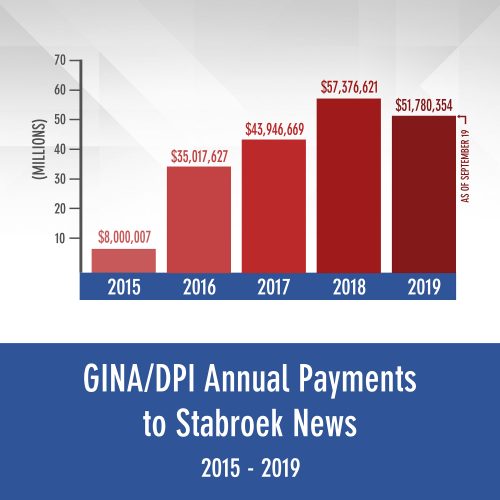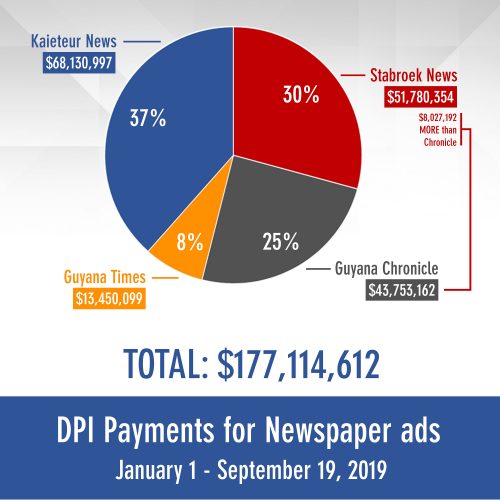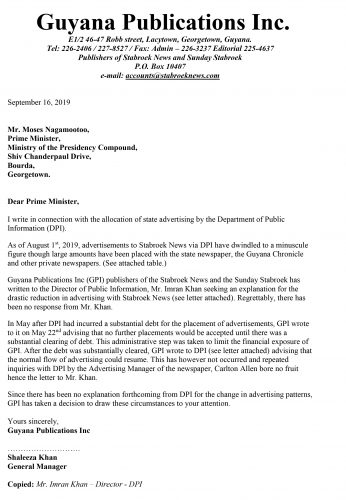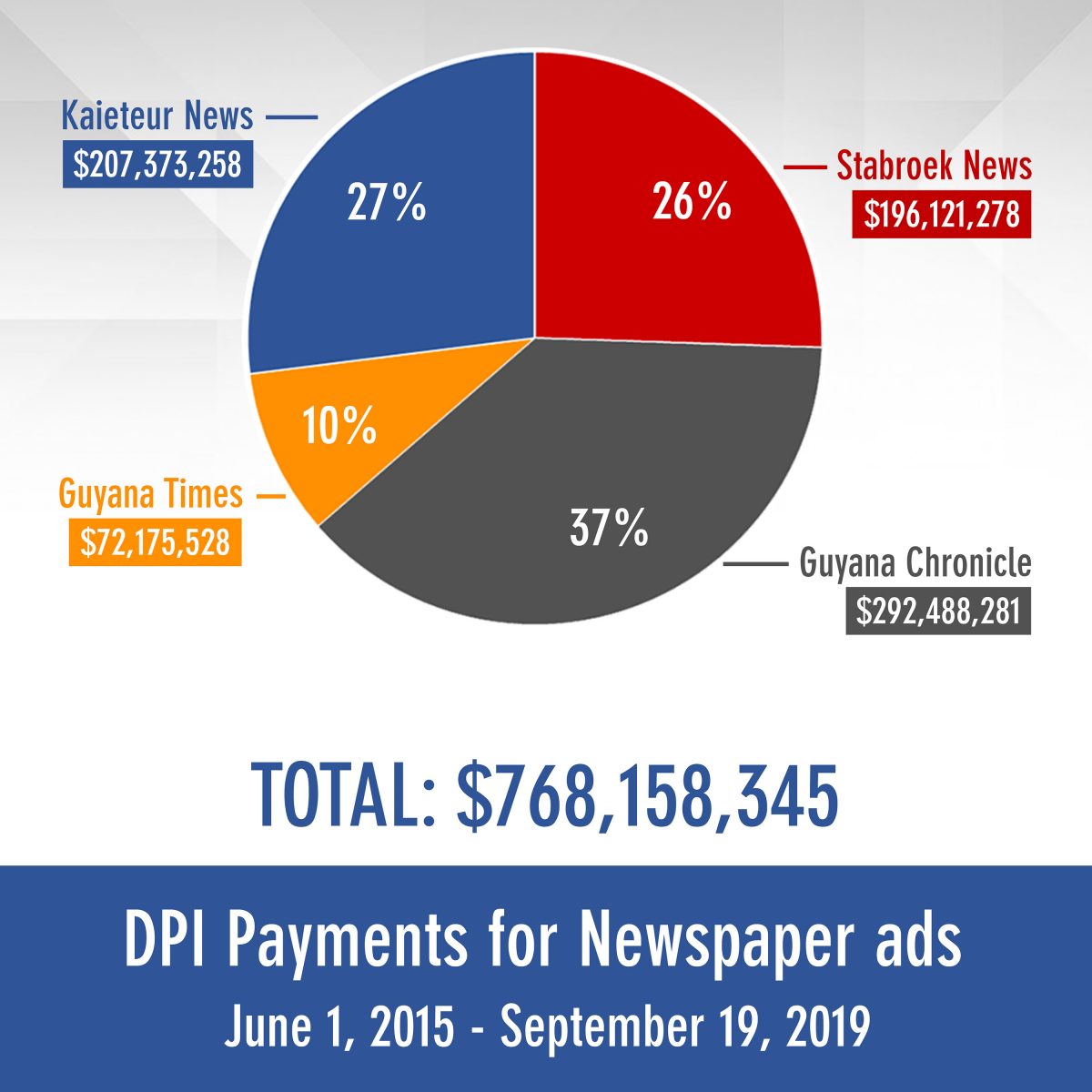The Department of Public Information (DPI) yesterday stated that the reduction of state advertisements in Stabroek News was a result of its decision to suspend bookings in May until significant arrears were cleared and it also announced a major shift in the manner in which ads are being placed.
DPI had provided a brief response on Sunday to a news item in that day’s Sunday Stabroek after a prolonged silence on the matter and provided a fuller explanation yesterday.
The news item had recounted how DPI had slashed state advertising in August and September to a trickle and Stabroek News Editor-in-Chief Anand Persaud had labelled it a crude attempt to muzzle the newspaper which had taken forthright positions on the government’s violation of the Constitution.

DPI in its statement yesterday said that it rejected the news item as “wholly erroneous, misleading and mischievous and presented what it said were “unvarnished facts.”
It said that DPI has paid a total of $177,114,612 in newspaper advertisements payments to the four daily newspapers for the period January 1 to September 19, 2019. Of this amount, it said that Stabroek News received $51,780,354 and the state-owned Guyana Chronicle received $43,753,162.
Persaud said the figure was misleading as while roughly $52 million was received for this year, $16.3 million of the sum pertained to arrears for the period October to December, 2018, while $35.4 million related to the period of January to August, 2019.
For 2019, DPI said that Stabroek News received $8,027,192 more than Guyana Chronicle in payments. Persaud said it would be very surprising that SN received more than the Guyana Chronicle which carried thousands more of column inches. He said it would either mean that the Chronicle was not being paid for some of these ads or that their advertising rates were exceedingly low.

DPI said that for the period June 1, 2015 to September 19, 2019, the former Government Information Agency (GINA)/DPI paid a total of $816,380,884 in newspaper advertising to the four daily newspapers. Of this amount, it said that Stabroek News received payments of $196,121,278, representing 24 per cent.
Further DPI said that under the Coalition Government GINA/DPI advertising payments to Stabroek News moved from $8 million in 2015 to a whopping $57.3 million in 2018. Persaud said it had never been a matter of contention that state advertising had increased substantially under the current government.
“Stabroek News was on course to an even higher figure for 2019 until it interrupted the flow of government advertising by imposing a blockade starting June 1, 2019. Stabroek News impaired its own ability to receive government advertising. At no time did DPI advise Stabroek News in any manner of any intention to reduce or cease booking of advertising with the newspaper. It was the newspaper which refused to take government advertising”, DPI said.
Persaud said Stabroek News’ temporary halt to government ads in May could under no circumstance be considered a “blockade.”

Overdue
DPI said it was conducting business as usual with Stabroek News without any issue. However on May 22, 2019 it said that the newspaper wrote to DPI advising that as of June 1, 2019 it would “cease all ad placements”. Persaud said the letter written to DPI stated as follows: “DPI’s balance as at yesterday, May 21, stands at $22,118,485 and includes February and March, 2019 which are overdue. As you are aware, DPI’s credit term is 45 days from the invoice date.
“We further wish to advise that a decision has been regrettably taken to cease all ad placements effective June 1, 2019, until we receive a substantial payment”.
Persaud said that this action was taken after repeated attempts by Stabroek News to secure payment for the months in serious arrears.
DPI said this action by Stabroek News was unprecedented and effectively resulted in the newspaper “by its own action, and of its own free will and volition blocking government advertisements from its newspaper”.
Persaud said DPI’s contention was not credible as the newspaper has the right to protect itself from unsustainable debt and the more natural course of action for DPI would have been to assiduously bring the debt down so that ads could continue being placed with Stabroek News. Persaud said the action by the newspaper did result in a steady reduction of the debt and this should have been seen by DPI as a positive development and an opening to resume advertising.
DPI said that the reason provided by Stabroek News for the “blockade” against government advertisements was spurious.
“The newspaper claimed that it was blocking government advertisements because of outstanding payments. This is ludicrous as the newspaper’s account at the time ($22,118,485) was not unusual and other newspapers have routinely had larger outstanding amounts. No newspaper has ever imposed a blockade on government advertising as a result.
“The action taken by Stabroek News was unnecessary, arrogant, unilateral, punitive and high-handed. Payments are expeditiously made to the newspapers for advertisements as monies are received from the various government ministries that use DPI to book advertisements. The bulk of the advertising placed by DPI is on behalf of these ministries and not from DPI’s budget. DPI served merely as a booking agent.
“There is a cyclical flow of payments and the accounts from time to time build up as a result of cash flow and other factors. These backlogs are cleared once funds are available and there is hardly ever a lengthy backlog of payments”, DPI said.
Persaud said that the newspaper had every right to take action as despite numerous entreaties to DPI to reduce the debt, the number kept rising and there was a lengthy backlog. Being accountable to a board and shareholders, the company could not allow unrestrained credit, particularly at a time when elections could have been called.
Alternative sources
DPI further noted that Stabroek News receives large volumes of advertising from some government ministries, agencies and departments which do not book advertising through DPI.
DPI acknowledged that once the
payments were cleared during the normal cyclical flow, Stabroek News wrote DPI to advise that it would resume receiving orders for government advertising. DPI said it did not receive requests for placement of advertisements for Stabroek News on as regular a basis as before the blockade or for prominent placement in Stabroek News.
It said that this was a direct result of Stabroek News’ own action, not DPI’s or the government’s.
“Stabroek News triggered a series of events which exposed its own lack of reach among the Guyanese citizenry and it is now crying foul”, DPI said.
Persaud said this was a nonsensical argument as the newspaper had found out on its own that several government agencies had been misled by DPI into believing that SN wasn’t accepting their ads when that was not the case.
DPI also said that it and the government generally began to explore other avenues of reaching the public.
“Digital media and radio advertising in particular came into focus. To compensate for advertising which Stabroek News blocked, DPI began advising ministries to place and increase advertising placements with various radio stations and digital media outlets along with television stations. DPI believes that given the vast reach of both digital media and radio government is receiving greater value on these platforms”, DPI said.
Persaud said that this explanation was not credible as state ads for newspaper have certain formats and content that would not be appropriate for digital media or radio. Persaud said the explanation proffered by DPI was suspiciously similar to the codswallop offered by the Jagdeo administration in 2006 when it justified the removal of ads by saying that it was looking for more impact for its dollar without showing how that was achieved.
“Stabroek News, in its typically arrogant manner, seems to believe that once it indicated that it had lifted its blockade that advertisements must resume immediately in full flow as if it alone is entitled to government advertising. No consideration was given to the fact that during the period of the blockade DPI and government would seek alternative means of advertising in the ever enlarging media world. In any event it will take some time following the lifting of the blockade for the normal flow of advertising to resume”, DPI said.
Persaud in response said that as a major media house Stabroek News did harbour the natural expectation that advertising would resume immediately as DPI served as a clearing house and played a part in channelling ads.
DPI said that several advertisements from itself; the ministries of Public Infrastructure, Legal Affairs and Public Security; Central Housing and Planning Authority, Maritime Administration and River Defence Department have been placed with Stabroek News during the period July to September post-blockade.
Persaud several of these were as a result of the insistence of the agencies after being advised by Stabroek News of the restoration of advertising.
High-handed
DPI further stated that as part of the process triggered by Stabroek News’ high-handed blockade, it has reviewed the placement of newspaper advertising and has been advising ministries that based on all the available information, advertising in all four daily newspapers is not a mandatory or legal requirement.
“The requirement favours advertisements in only two print media. DPI has advised ministries that advertisements would be placed in two newspapers – Guyana Chronicle (as the state owned newspaper) and on a rotational basis with one of the other newspapers along with television, radio and digital media. There is a diversification of government advertising to include all media, not just newspapers. This system has commenced and as the newspaper with the widest daily circulation Kaieteur News has received the bulk of the rotation thus far. Stabroek News is included in the rotation and has been receiving advertising as outlined above”, DPI added.
Persaud said these statements further undermined DPI’s arguments. He questioned how were any of the newspapers and digital media to learn about this new plan for state advertising. DPI had maintained a stony silence in the aftermath of the curtailing of ads to SN. It issued no statement or advisory to any media house so that they could be aware of the rotation of ads to media houses and that ads would now only be placed with two newspapers. This explanation was only presented after Stabroek News went public and some policy had to be made up, Persaud said, while adding that this was propaganda akin to the same type of arguments that had been floated by the Jagdeo administration.
Second, Persaud said that state media have no inherent right to be treated more favourably than any other media house and that this was a throwback to the capture of these agencies to do the bidding of the government as opposed to solely performing an information function. He said that the APNU+AFC’s handling of the Chronicle is akin to the manner that the PPP/C government behaved.
Third, Persaud added that it was interesting how DPI decided on its own who had the highest newspaper circulation without the apparent benefit of hard information.
DPI also said that “given the evolving nature of media and the rapid expansion of access to information by the public on digital media platforms, it is incumbent on all advertisers, including government, to adjust and modify the manner in which advertising is placed (i) for maximum benefit and (ii) to ensure that all media share in the government advertising pie and not mainly newspapers only”. Persaud said this excuse had echoes of what was heard in 2006 when ads were cut off to Stabroek News.
SN campaign
DPI also said that it viewed the Sunday Stabroek article as a “heightening of the newspaper’s campaign against the government. Its regular attacks against the administration is known…”
Persaud said the newspaper was doing what it had been doing all the time: holding the government of the day accountable. It has taken a firm line on two particular issues – the unconstitutional appointment in 2017 of James Patterson as the Guyana Elections Commission Chairman and the government’s defiance of the constitution in relation to the passage of the motion of no-confidence on December 21, 2018.
DPI also said it has confirmed that Stabroek News has previously refused to accept advertisements from the Ministry of the Presidency unless the newspaper was paid upfront which it said was a highly unusual practice. Persaud said that a department of the Ministry of the Presidency had incurred a significant overdraft and had been told that future ads could only be accepted on a cash basis.
DPI also said it has also “confirmed” that the newspaper had advised the Ministry of the Presidency (MOTP) that it is not the policy of the newspaper to publish press releases from MOTP, even though the newspaper is known to routinely publish press releases from other entities and sometimes do so unedited and in full. Persaud said that he was bewildered by this claim as there is no such policy. He noted that a large number of press releases from the MOTP are rewritten and published, particularly those with news value. A check of the newspaper’s online archive would show that the MOTP receives fair coverage and the DPI claim to be baseless.
Persaud noted that the newspaper does carry verbatim releases online for speed of information release.
DPI added that it wanted to assure the public “that there is no removal of government advertising from any newspaper. There is no evidence whatsoever to support the false allegation that the government was stifling the free press. Any claims to that effect are erroneous, malicious and self-serving”.
Persaud said this statement was not grounded in reality as DPI did not provide ads to Stabroek News in September and only provided an explanation on Sunday, 31 days after the Director of Public Information Imran Khan had been written to by the General Manager of the newspaper company, Shaleeza Khan, seeking an explanation.
DPI added that upon receipt of the letter from Stabroek News, Prime Minister Moses Nagamootoo, who holds the portfolio for Public Information, requested a detailed explanation from DPI. The explanation, has now been provided publicly. Persaud said that PM Nagamootoo was written to on September 16 and no acknowledgement or reply came until yesterday, 14 days after the fact. It was dated September 26.
Persaud said that Stabroek News remains of the view that the administrative decision it took to manage its debt was seized upon by DPI to punish it for its editorial line. Persaud said that SN would continue to monitor the manner in which state ads are distributed, and it will report this to press freedom bodies and related institutions.









